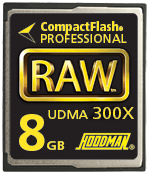
I decided to use my recent trip to Dubai to field test Hoodman’s RAW high-speed 300X 8GB UDMA memory cards, and I also used their high-speed UDMA card reader (because without a high-speed reader, you’re not getting all the benefits UDMA brings).
The main thing I’m (we’re) always concerned about is reliability. It doesn’t matter how fast the cards are if they fail, and so far I’ve put thousands of images on the cards and they’ve performed flawlessly (which I expected because of my experience with Hoodman products in the past). Beyond that, I’ve been very impressed with the speed. It writes to the card very fast, it downloads back to your computer very fast—in fact, I didn’t realize how big a difference UDMA Cards would make, but now I see what all the fuss is about.
OK, so they’re really fast and they’re really reliable. So what’s not to like? The price. For example:
- Lexar’s 8GB 300X UDMA card is going for around $170 at B&H Photo.
- Sandisk’s 8GB Extreme IV UDMA card is going for around $180 from B&H
- Hoodman’s 8GB 300X UDMA RAW cards are $250 (direct from Hoodman).
Both Lexar’s and Sandisk’s cards both use the fast UDMA technology, too; both have a good reputation for reliability, but as big a fan as I am of Hoodman’s gear (I swear by their stuff), I’m having a really hard time justifying the $70 to $80 more per card without a clear and distinct advantage over the competition.
Now, that being said, there may be an advantage to the Hoodman RAW cards that I’m not aware of, which justifies the higher price, and if that turns out to be the case, I’ll absolutely update this report, but until then; that’s my report. REPORT UPDATE: Hoodman responded to this review noted precisely why their cards cost more, and are worth the extra cost. Here’s the link to that post.


